How To Keep Socks Clean
Our Editors independently research, test, and rate what we feel are the best products. We use affiliate links and may receive a small commission on purchases.
It's easy to underestimate how important your choice of hiking socks can be.
The best hiking socks will protect your feet from blisters, abrasion, and debris so your choice of socks can be crucial.
They're a fundamental part of your hiking gear and choosing the right hiking socks means understanding the materials they're made of.
Get it wrong and you'll be left with blisters or feet that just won't dry out after a river crossing. We'll take a look at some of top socks available. Let's get started!
Best Hiking Socks
| Darn Tough Hiker Micro | Wigwam Ultra-Lightweight | Smartwool PhD Mountaineer Socks | |
|---|---|---|---|
| | |||
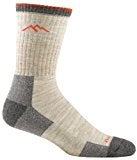 | 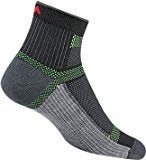 | 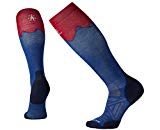 | |
| Fabric: | 61% Merino Wool, 36% Nylon, 3% Spandex | 43% Nylon, 32% Acrylic, 22% Other Fibers, 3% Spandex | 50% Merino Wool, 43% Nylon, 7% Elastane |
| Style: | Crew | Quarter Length | Over the Calf |
| Best For: | Hiking Boots | Hiking Shoes | Hiking Boots |
| | | |
For more of my hiking gear recommendations, have a look through these popular Outside Pursuits guide links: Hiking Shirts, Hiking Shoes, Hiking Pants.
Quick Answer: The 10 Best Rated Hiking Socks For 2021
Crew Fit Hiking Socks
- Darn Tough Hiker Micro Crew Socks
- SmartWool Men's Hike Medium Crew
- Darn Tough Merino Wool Full Cushion Sock
- Injinji 2.0 Outdoor Crew Nuwwol Socks
- Columbia Hiking Light-Weight Merino Crew
- Thorlos Lite Hiking Moderate Padded Crew Socks
Quarter Length Hiking Socks
- Wigwam Cool-Lite Mid Hiker Pro Quarter Sock
- Wigwam Ultra Lightweight Quarter Sock
Over the Calf Hiking Socks
- Smartwool PhD Mountaineer Socks
- Darn Tough Hunter Over the Calf Extra Cushion Sock
Our reviews of the top rated hiking socks with our guide and comparison table will help you choose the right pair for you. I know you're here to find the best socks on the market today. Here's our top recommendations.
Best Crew Hiking Socks
#1 Darn Tough Hiker Micro Crew Socks
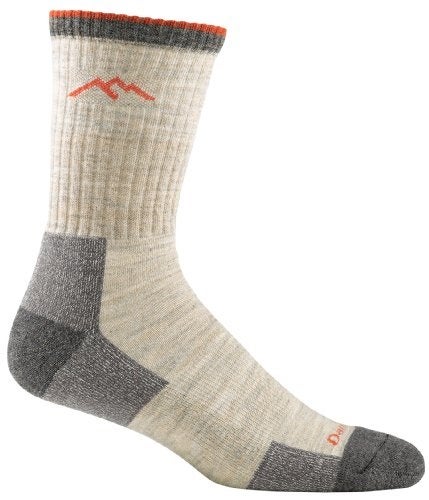 Darn Tough is my favorite sock manufacturer and the only one I currently use. Why? Because they'll give you free new ones every time one wears out! I've tested their guarantee, it works.
Darn Tough is my favorite sock manufacturer and the only one I currently use. Why? Because they'll give you free new ones every time one wears out! I've tested their guarantee, it works.
They stand by it!
On top of that, they use a combination of Merino Wool and nylon to get the best results. Merino is amazing at wicking and drying while nylon helps the sock last a long time before it does wear out.
This sock is tall enough for a boot, but shorter than a mountaineer sock.
There's plenty of extra heel and toe padding on these and I've found that Darn Tough keeps their toe seams perfectly flat. Totally unnoticeable and great for a traditional leather hiking boot. Overall, these are probably the best socks for hiking.
Women's Model: Darn Tough Hiker Micro Crew Cushion Socks
![]()
#2 SmartWool Men's Hike Medium Crew
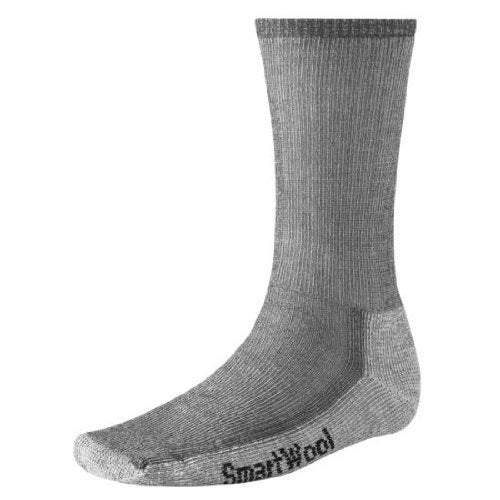 Medium weight, medium cushion, full length sock for any size hiking boot. If you're not sure what hiking sock is right for you, this might be the one.
Medium weight, medium cushion, full length sock for any size hiking boot. If you're not sure what hiking sock is right for you, this might be the one.
With a name like "Smartwool" you have to assume they make some of best merino wool socks and you would be right!
It's got enough length for any normal hiking footwear. Enough padding for any hiker, but it's not overdone. The sock is padded all the way from front to back which I tend to like less than socks which are area-padded.
Smartwool also makes a great product and there's not much to fault in their socks. If you can afford the top-grade price of Merino then go for it!
It will be worth it overall, though Darn Tough makes a hard case with free replacements for life and nearly the same sock design and materials.
Women's Model: SmartWool Hike Medium Crew
![]()
#3 Darn Tough Merino Wool Full Cushion Sock
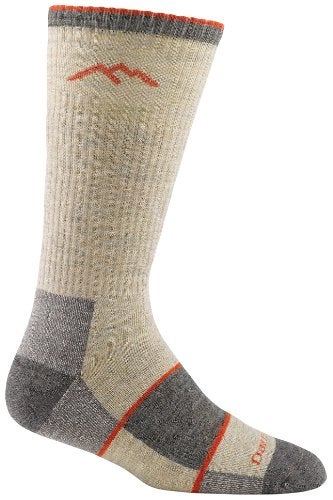
These totally seamless socks are smooth and nearly flawless. DT's construction on their seamless socks is top notch and I can vouch for that.
This particular sock is a full height super-padded sock perfect for traditional hikers with large boots. If you're the kind of hiker who relies on full leather massive hiking boots to get the job done, this sock will keep up with you.
As always, they're rocking a combination of Merino, nylon, and spandex for the clutch blend of fibers. Always solid, definitely some of the best backpacking socks you can buy!
![]()
#4 Injinji 2.0 Outdoor Crew Nuwwol Socks
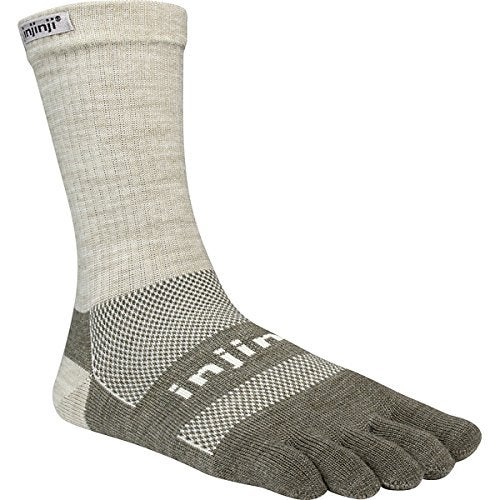
Injinji has been around for years and seems to gain and then lose traction within the hiking community. The socks have an extremely unique feature – individual toe pockets!
Overall, I like the thin to medium area padding of these uni-sex socks, which seems to be intelligently placed in the most necessary locations.
If you're a hiker with toe blister problems, Injinji socks might just be your savior. Why? Because the individual toe pockets help to smooth the friction between and around toes.
Hikers with several blister issues sometimes swear by these socks and they might just be the best hiking socks to prevent blisters! If you have unusual size or shape toes, you may struggle to get a perfect fit however.
![]()
#5 Columbia Hiking Light-Weight Merino Crew
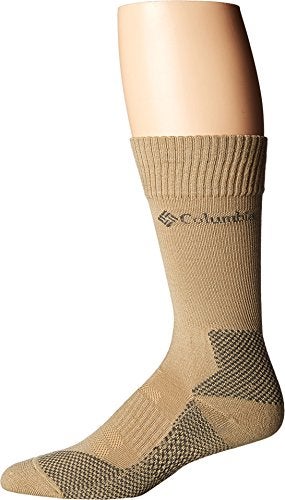
Columbia has finally made it into the Merino Wool sock scene. If you've read my other work then you'll know that I'm a huge fan of Columbia. Why?
Because they tend to make good gear at great prices. They're a value driven company and these Merino Wool crew socks are a move in the right direction!
I like that these uni-sex socks are area padded, leaving the material thin in some areas, and thicker in others. This puts the padding where it's needed without making the overall sock too warm or thick.
They also included an extremely thick and robust upper welt which should help hold up this thick sock and prevent bunch or falling. A good choice for those looking to get tons of padding with breathability in the right places.
![]()
#6 Thorlos Lite Hiking Moderate Padded Crew Socks
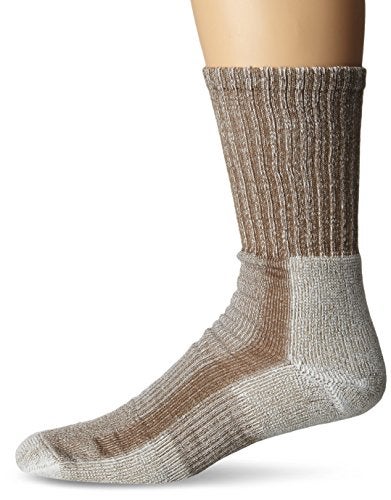
Another full-length crew sock, this one is medium padded through and through. There's no extra breathable areas or localized padding. I do like the extra reinforced instep area which holds tightly to the foot helping to prevent bunching or moving.
They made the sock out of some proprietary "THOR" material which honestly just serves to make it a bit harder to figure out if its a good choice.
However, considering the value of the sock and the overall medium to thick padding build, it would make a solid choice for a traditional hiking footwear user in spring, fall, and winter conditions.
Perhaps a bit too thickly padded for comfortable summer use.
Women's Model: Thorlos Unisex Ultra Light Hiking Crew
![]()
Best Quarter Length Hiking Socks
#7 Wigwam Cool-Lite Mid Hiker Pro Quarter Sock
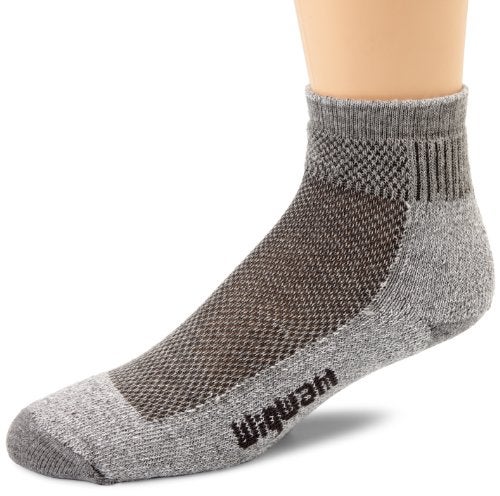
These nylon, polyester, cotton, and acrylic blend lightweight hiking socks are a rather unusual combination. They should, however, stand up just find to normal hiking use and perform well under sweaty pressure.
They're a mid-weight sock which is probably best for 3-season use. Unless you're an ultralight purist or trail runner with absurdly thin footwear, these socks will take care of the job.
They moved the seam on the sock above the toes which is generally fitting, but beware if you have tight fitting shoes. It could chafe.
Women's Model: Wigwam Unisex Cool-Lite Pro Quarter Length Sock
![]()
#8 Wigwam Ultra Lightweight Quarter Sock
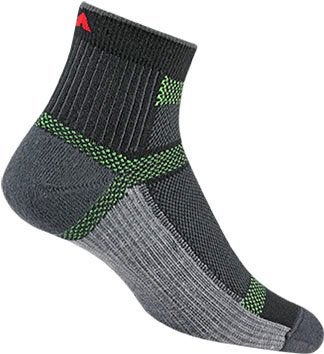
Now we march squarely into my realm of preference. I wear trail running shoes and quarter length ultralight socks when hiking. Why? They dry quickly, they're lightweight, and they pair well with my choice of hiking shoes.
I love how thin Wigwam made the tops and sides of these socks. This allows for an insanely cool summer hiking socks for warm weather. Reinforced toe and heel areas help with durability but make no mistake, they're not added for padding.
The sock is nylon and acrylic primarily. I would have liked to see polyester or merino included. Overall these moisture wicking socks are near the perfection mark for my tastes!
Women's Model: Wigwam Ultra Cool-Lite Ultimax Ultra-Lightweight Quarter Sock
![]()
Best Over The Calf Hiking Socks
#9 Smartwool PhD Mountaineer Socks
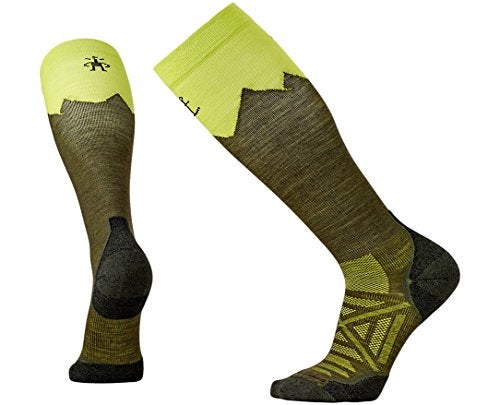
Smartwool, if you don't already know, is notorious for their almost pioneering use of Merino Wool. Thus, the name. That said, they made a good call with these uni-sex socks to go nearly half Nylon.
Why is that good? Remember, Merino can be a bit delicate by itself and Nylon is extremely durable. It's a great combination that is particularly effective at extending the life of your socks.
These are over the calf type socks which are most appropriate for winter hiking in tall or thick boots. Thanks to the name, we might surmise that they're actually intended for use with mountaineering boots. Either way, big boots, big socks.
![]()
#10 Darn Tough Hunter Over the Calf Extra Cushion Sock
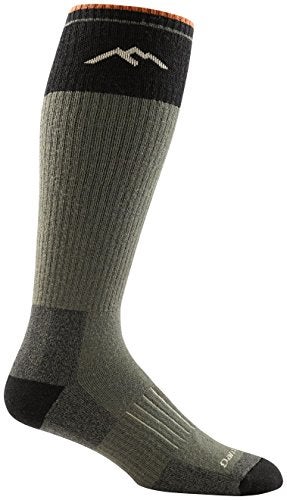
As you can tell we like Darn Tough! As our last pair of hiking socks the, over the calf Hunter socks work just fine with any full-size hiking boot or hunting boot.
Being made mostly from merino wool they are a good choice for vigorous hiking where you need breathability so your feet don't get sweaty. As long as you wear them with a pair of shoes or boots that allow the sweat to evaporate.
They have some nylon and lyra spandex integrated so they keep their shape and don't slip down your calf. Merino wool as we discussed is excellent at keeping bacteria from growing and your feet from stinking.
They of course come with Darn Tough's lifetime warranty so you can feel safe knowing they will last you a long time!
![]()
Hiking Socks Comparison Table
| Hiking Socks | Made From | Height | Cushion | Best For | |
|---|---|---|---|---|---|
| Darn Tough Hiker Micro |  | 61% Merino Wool, 36% Nylon, 3% Lycra Spandex | Crew | Medium | Shoes/Boots |
| SmartWool Men's Hike Medium |  | 66% Merino Wool, 33% Nylon, 1% Elastane | Crew | Medium | Shoes/Boots |
| Injinji 2.0 Outdoor |  | Merino Wool / Other Fibers | Crew | Medium | Shoes/Boots |
| Columbia Hiking Light-Weight | | Merino Wool / Other Fibers | Crew | Medium/Heavy | Shoes/Boots |
| Thorlos Lite Hiking |  | 81% Synthetic, 14% stretch nylon, 5% spandex | Crew | Light/Medium | Shoes/Boots |
| Smartwool PhD Mountaineer |  | 50% Merino Wool, 43% Nylon, 7% Elastane | Calf | Heavy | Boots |
| Wigwam Ultra Lightweight |  | 43% Nylon, 32% Acrylic, 22% Other Fibers | Quarter | Light | Shoes |
| Wigwam Cool-Lite Mid Hiker Pro |  | 88% Polyester, 22% Stretch Nylon, 20% Acrylic | Quarter | Light/Medium | Shoes |
| Darn Tough Merino |  | 67% Merino Wool , 36% Nylon | Full | Heavy | Boots |
| Darn Tough Hunter Over the Calf |  | 61% Merino Wool, 36% Nylon, 3% Lycra Spandex | Full | Medium | Boots |
How to Choose the Best Socks For Hiking
- Material
- Warranties or Guarantees
- Sock Height
- Padding
- Comfort
- Durability
- Care
- FAQs For Hiking Socks
- The Case For Thin Socks
- Conclusion
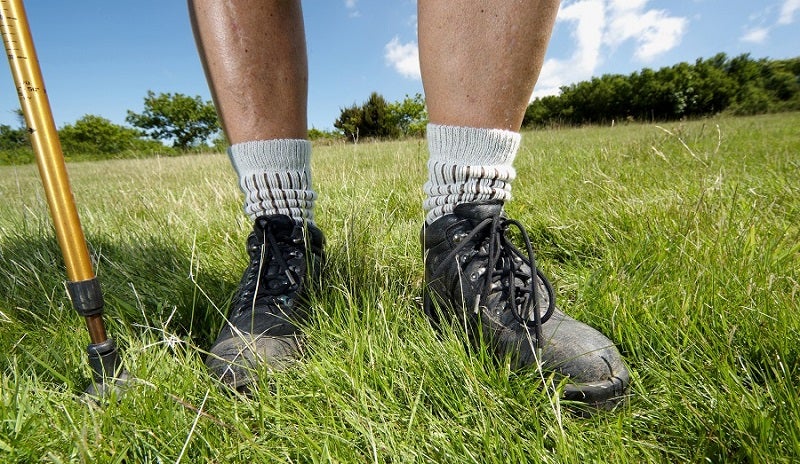
Let's start with the fundamentals and work through everything you need to consider in choosing a hiking sock.
Hiking Sock Materials – Which is Best?
First and foremost, on the consideration list is the material your socks are made of. You've generally got four components so let's tackle them one at a time.
Merino Wool
Is a water wicking fiber which is popular in high-end socks. It has excellent moisture absorption and exceptional odor control. Choose merino wool if your budget is large or if you're hiking in the winter. Merino wool tends to be less durable than other fibers.
Polyester
Similar to Merino in that it is an excellent moisture mover. Polyester dries quickly and does its job effectively. It's also much cheaper than Merino to produce and therefore the socks will be more affordable. It lacks the odor control properties of Merino but tends to be a bit more durable.
Nylon
Nylon is a common addition to sock fibers. Socks are never made solely of nylon. It is added to increase the strength and durability of socks. This is particularly useful when paired with the less durable Merino and polyester fibers for a combination of characteristics.
Lycra, or Spandex
These fibers are almost always present in socks. This material is there to add in stretch which accommodates different foot sizes and allows the sock to stay on your feet.
Some or all of these will be present in any hiking sock. Checking the fabric contents on the tag or package will help you understand how the sock is meant to perform.
Warranties or Guarantees
There's no doubt – Darn Tough made this one popular. In fact, I know of no other companies off the top of my head that offer a guarantee on their socks.
Essentially, Darn Tough will guarantee that their socks last forever and can't be worn out. Of course, the socks can be worn out. But that's the beauty of it. Just send them the socks back and they'll mail you a brand-new pair totally free. Yeah, I've tested it. It works.
It's a great way to get an unlimited supply of amazing socks.
Hiking Sock Height
This one totally depends on your footwear choice.
Me? I wear trail runners and ¼ high socks. It just works.
Whatever you do, don't go with low cut socks. You don't want the hiking shoe or boot chafing against your bare skin. For those hiking with full boots, choose a full-length sock. No doubt!
If you're not sure, err on the side of caution. There's little added bulk or weight in packing taller socks for hiking, but having short socks just won't work at all. What have you got to lose?
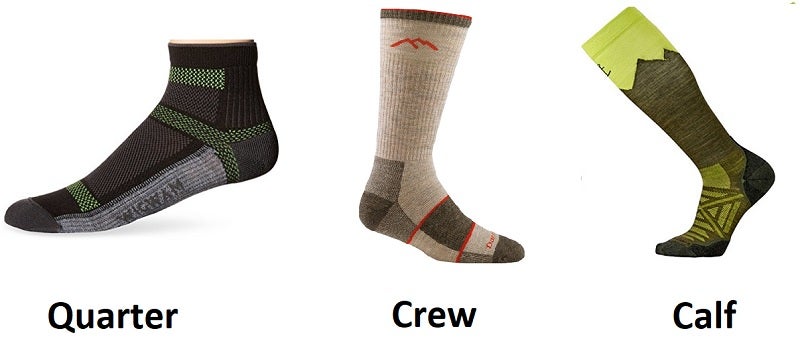
Socks Cushioning & Padding
Before buying your hiking socks it's a good idea to determine how much cushioning you need. Here are the options:
Liners
If you spend much time in the outdoors in the winter you probably use or are familiar with glove liners. These are just a very thin layer of fabric, often made of Merino wool. If you have used them in gloves before you know how much warmth they add!
Well you can do the same thing for your feet. A thin layer of material you wear underneath your socks. They have no padding and add extra wicking to keep your feet not only warm but dry.
Ultra-Lightweight
Similar to liners, ultra-lightweight hiking socks are thin and very breathable but providing little cushioning. If they have any cushioning at all it will usually be under the heel. For very cold conditions you could use them like a sock liner.
Lightweight
Moving up the thickness scale, we have lightweight hiking socks. Providing move cushioning and of course slightly thicker. Normally have some compressive properties and best for warm weather conditions where moisture wicking is especially important.
Mid-Weight
Probably the most popular type of hiking sock, mid-weight are thicker yet and almost always have some cushioning in the toes, heel and around the ankles. Typically a durable sock with reinforcement to add to their durability.
Full-Weight
Sometimes known as "mountaineering socks" they are the thickest and warmest socks available. As you may have guessed, they are also fully padded all around and meant for long treks in mostly cold or frigid conditions. Definitely not for warm weather use!
Hiking socks will come with an absolutely mind-boggling array of padding types. It's insane and totally unnecessary. However, you've still got to deal with and pick out the best one for you.
I find that I prefer socks with toe and heel padding underneath simply to extend the life of the sock. Those areas tend to wear out first so having thicker material helps them stay alive. I've yet to notice an effect on the health of my feet due to padding – feet hurt after a long day of hiking- period.
I will say to beware of over padding. This can make the shoes or boots fit poorly and actually increase the chaffing and abrasion inside the shoe or boot. That will lead to blisters and all manner of not fun foot pain.
You may simply have to experiment with different levels of padding until you find what works best for you.
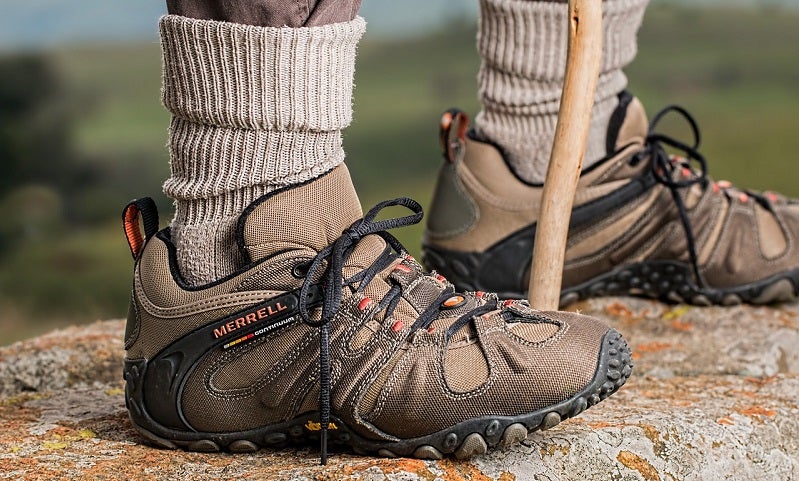
Comfort
Overall most hikers agree Merino wool is a comfortable material for socks so I would put socks made of it at the top of your list. Socks are always a blend though, there is no such thing as a 100% wool sock.
Synthetics are blended in to give it elasticity and keep its shape. Not all of the socks on our list are Merino wool with WigWam being a notable exception.
Generally socks made from all synthetics are more inexpensive and many do perform quite well and are comfortable. In addition have a blend gives the socks more durability. Merino wool excels in many categories but durability is not one of them.
Durability
Merino wool as mentioned above is not known for being durable. Being socks take a lot of abuse being stuck in a shoe/boot all day and possible many days in a row achieving a level of durability you expect from your socks is not easy.
Darn Tough has managed to figure this out, their Merino wool socks come with a lifetime warranty! Hard to believe and they really do honor it. After that the Smartwool hiking socks are another sock known for its durability.
The one issue that Merino wool has is "pilling" which is the little balls on the outside of the socks. You can lesson this by not using the dryer all the time.
All of the hiking socks on our list should give you a few season of use and maybe more depending on how you take care of them and use.
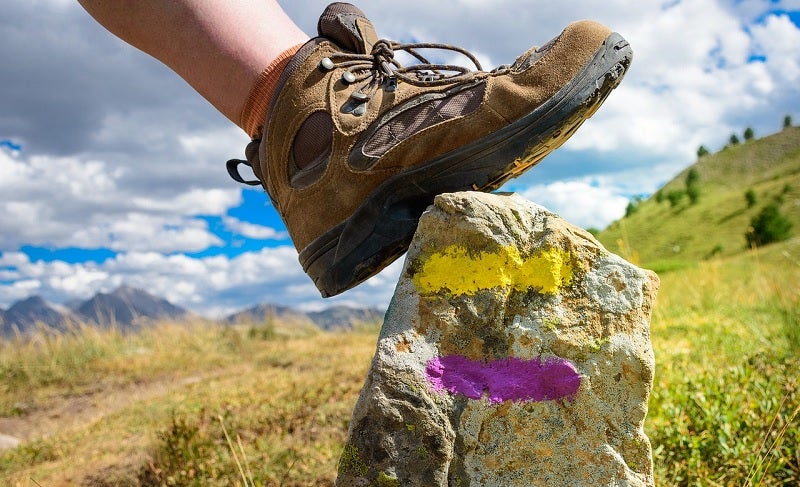
Caring For Your Hiking Socks
On the trail you can keep your socks clean to extend their life (and save your nose). Cleaning your socks will get rid of debris and bacteria both. This helps the sock live longer by preventing breakdown of fibers.
Additionally, a clean sock is a lot less likely to give you an infected blister. If you're dealing with blisters keeping them clean is critical to staving off infection and clean socks mean happier blisters.
To wash your socks on the trail (or any garment, really) use a gallon ziploc bag with a few drops of Dr. Bronner's soap and a decent amount of water. Put a few pair of socks in there and shake them vigorously until that water turns nasty colors. Dump the water, rinse the socks, and hang them from your backpack to dry!
A synthetic blend only sock has very little in the way of care, just wash as you would anything else and toss in the dryer.
Synthetics don't suffer from pilling like Merino wool..
Hiking Conditions
Certain fabrics will perform well under most conditions, whether temperatures are warm or cold, dry or wet, Merino wool tends to perform well. With some other fibers weaved in for extra durability this is the almost perfect combination of material.
Keep in mind that synthetic fibers like polyester do not perform well when they get wet. They do not tend to dry as fast, be as comfortable and keep away odors like Merino tends to do.
FAQs About Hiking Socks
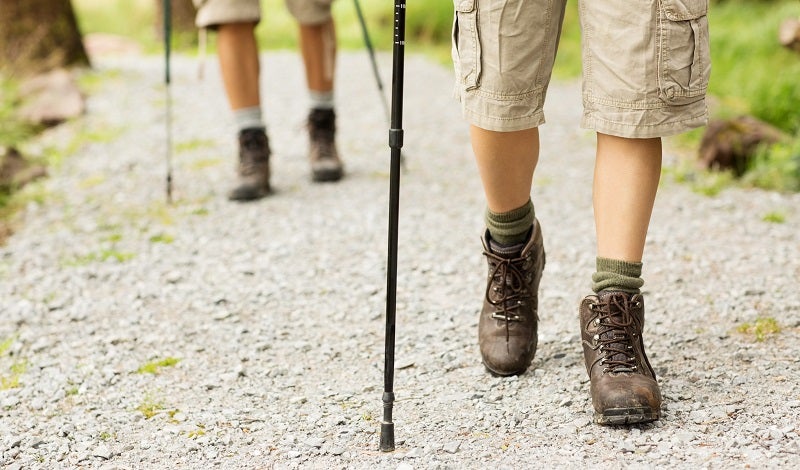
Q: What makes a hiking sock different than a regular sock?
A: Good question!
Hiking socks are a little bit different than your standard sock in a couple of ways.
- Selective padding
- Wicking fibers
- Reinforced weaves
- Boot heights
Of course every sock comes in different heights. However, when you're hiking it's more important than normal to match that to your boot and most sock makers for outdoor gear have very specific types for this.
Selective padding and reinforcement are important for hiking socks more than daily socks. Specifically ball of the foot, heel, and sometimes calf are usually padded. Padding in the center and top of the sock is usually minimal to keep the sock cooler while wearing.
Wicking fibers are used to help dry the foot and avoid swampy feet.
Q: Should I go cheap or expensive on my hiking socks?
A: This one depends a bit. I usually don't mind paying extra for my hiking socks.
For me, hiking socks end up being my daily divers as well as trail socks. I just use them all the time. That way I get my money's worth.
The most important factor for me, however, is that I use Darn Tough socks which have a lifetime replacement warranty. That means while I pay $12-$18 per pair upfront that goes down to $6-$9 the first time I replace them. That goes down to $4-$6 per pair the third time I replace them and so forth.
Q: What are waterproof hiking socks?
A: These little doodads, usually made of some fancy combinations of neoprene (diving suits) actually keep your feet dry! Even when your boots or shoes get soaked, you just keep happily hiking on with waterproof socks!
They made a little bit of a showing a few years ago among some of the ultra-hikers pushing the limits. However, they're not the most viable option and they've struggled to get a good following.
Mainly the drawbacks are that the socks are thick, hot, heavy, and tend to wear out quickly. Once the socks begin to wear out due to friction and abrasion you can say bye bye to the waterproofness.
Ultimately I wouldn't recommend them to anyone but they can be a possible solution to wet, macerated feet for some hikers if you want to deal with the drawbacks.
Q: Are my socks responsible for my blisters?
A: Possibly…
There are a couple ways socks can cause blisters.
First, check to make sure your socks are pulled up and falling down into bunches under your feet. These will causes hot spots and blisters.
Second, check to make sure there are no lumps or debris stuck in the sock. A bit of a twig, a tiny pebble, or other debris can cause chaffing which will cause a blister.
Third, watch out for seams in your sock. Sewn or woven seams in the sock itself that aren't flat can be blister spots.
Q: Are thick hiking socks the best at padding my sore feet/keeping me warm?
A: Ehh… sometimes.
Padding is good and bad. Too much padding can lead to problems as surely as too little.
Buying socks that are thickly padded all over will simply result in sweaty hot feet that get gross and soft. This will lead to blisters and potential cold injuries in the winter months if you're not careful.
Look for thick padding just on the balls of the feet and the heel or calf. Other than that, most of the time you'll want socks that are relatively thin in the rest of the areas. If you're hiking in particularly cold weather you may want to go with a sock that's thicker and warmer, but within reason. Hiking will keep you warm for the most part.
Some people make the mistake of going with an overly thick sock for warmth. If your shoes or boots are too small and the sock padding grows too large for the footwear, it will surely lead to cold toes.
When the sock gets compressed by small boots or shoes your foot loses both insulation and blood flow. That's why it's never a good idea to stuff an overly-thick sock into small footwear.
The Case For Thin Socks
During 3-season hiking there's a strong case to be made for thin hiking socks. Namely, they may be the best possible choice of sock you can make.
Why?
Well, let's say you subscribe to the idea that your socks, boots, and shoes will get wet at some point during a 3-season hiking trip. You understand that there's just about a 0% chance of keeping those babies dry.
So, once they do get wet you probably want to have the best chance of getting them to dry out quickly, right? Right.
So what dries quicker, a big ol' ¼" thick wool calf-length boot sock or a quarter length thin polyester/merino running sock? You guessed it – the thin polyester running sock is a lot more likely to dry out quick!
Of course this only stands to reason if you first accept the fact that your socks are going to get wet at some point during a long hike. If you manage to keep your socks dry 100% of the time then it doesn't really matter.
Tips for Hiking Socks
Here are our top tips on how to choose the right ones, which ones to stay away from, and even how to wear them.
Tip #1: Have Different Hiking Socks for Different Seasons/Weather
Depending on the weather, which is usually dependent on the season, you may need different hiking socks. While you still need cushioning when hiking in the summer, it's important not to wear socks that are too warm.
In the winter, it's important to wear socks that are thick enough and made out of the right material, usually wool, to keep your feet warm. You may even find that layering your socks when hiking during cold weather can actually help keep you warm, just as layering other articles of clothing does.
Tip #2: Stay Away From Cotton Hiking Socks
Cotton socks are the enemy of hikers everywhere. Instead of wicking away moisture, they hold on to it. This can cause chafing, blisters, and other uncomfortable irritations. Because they hold onto moisture for such a long time, it can be difficult to dry them out should your feet become wet. It's best to stay away from hiking socks made with cotton.
Tip #3: Make Your Boots Fit Better With The Right Socks
If your hiking boots are just a tad too big the right pair of socks may make them more comfortable and help prevent irritations that arise from footwear that doesn't fit properly.
If going down to a smaller size boot is too small, pick the hiking boot that fits you the best even if you have a bit of room. A hiking sock that's a bit thicker may help to take up some of that room within the boot so they're more comfortable.
Tip #4: Wear Two Pairs of Socks
Many hikers have adopted a system of wearing two pairs of socks when hiking. This also works during the summer months based on the two styles you choose. The inner liner is a very thin sock that goes on first.
While the main sock moves slightly within the boot while walking, the inner liner stays put against your skin and this reduces irritation from rubbing. Depending on the season, the material and thickness you choose for the main pair will be different. Follow the same rules as choosing hiking socks for various weather when deciding on the main sock.
Final Thoughts
Hiking socks come in hundreds of flavors. It's up to you to make the best choice for your hiking style, weather, time of year, and footwear. Remember to choose a sock that makes the most sense when paired with your level of activity.
Overall, I highly recommend socks with some blend of nylon and polyester or Merino Wool. It's hard to beat that dream-team combination of fibers!
How We Researched
To come up with the top hiking socks we researched a variety of sources for reviews such as REI, Bass Pro Shops, Cabelas and Backcountry along with our own personal experience.
We also consulted online magazines for product research and reviews to get as much unbiased information as we could. To help weed out fake reviews we used Fakespot.com to make sure we only looked at genuine reviews.
With so much quality gear available, we had to narrow it down based on what we felt were the best options for the price. The author, Casey Fiedler has been leading backpacking trips for over a decade in his native state of Michigan.
To help narrow down the selection he used his personal experience along with recommendations from fellow guides and outfitters.
After extensive research, we came up with our list to help you choose the right one for you.
Sources
I hope this guide was helpful for finding a good pair of hiking socks to fit your needs. If you want to comment or recommend a pair of socks I didn't include, please use my contact form to get in touch.
Have fun and be safe out there!
How To Keep Socks Clean
Source: https://www.outsidepursuits.com/best-hiking-socks/
Posted by: mcclanahanlitend1940.blogspot.com

0 Response to "How To Keep Socks Clean"
Post a Comment